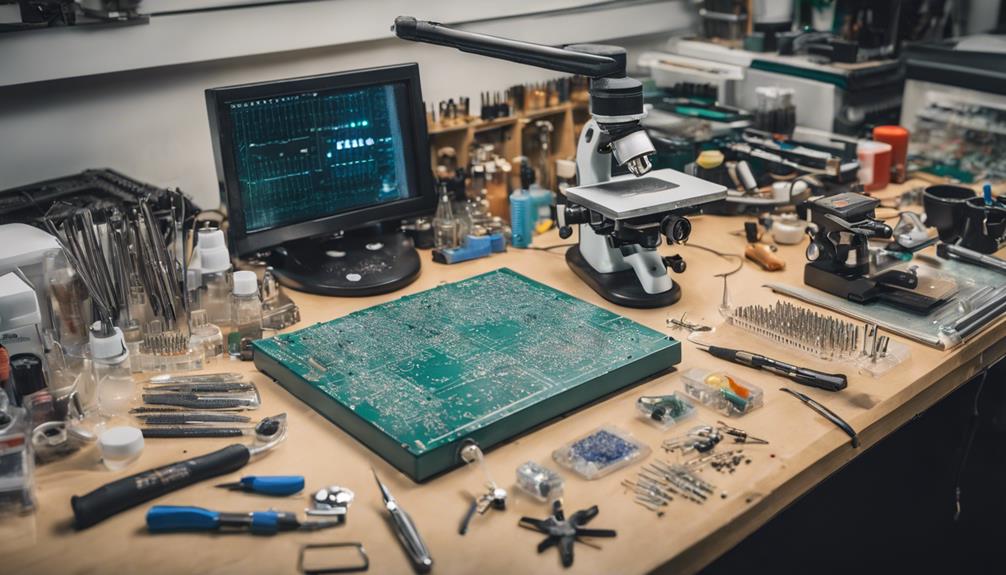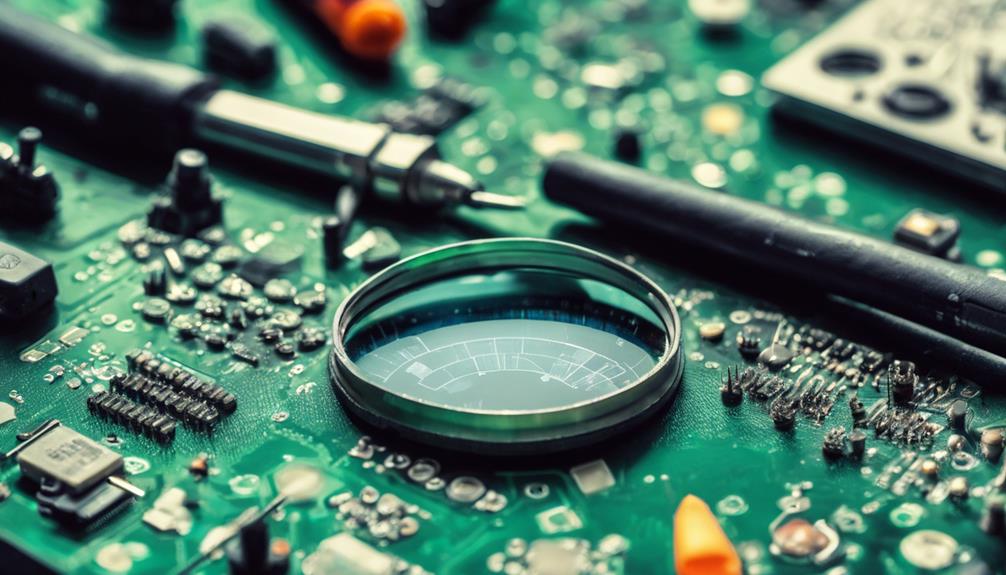To guarantee successful BGA rework and repair, it's essential to master precise techniques, invest in quality tools, and adhere to stringent quality control measures. A thorough understanding of removal, cleaning, pasting, and replacement processes is indispensable, as is proper solder paste application and temperature control. Investing in high-quality equipment and maintaining a safe, organized workspace are also fundamental. Additionally, thorough inspection and quality control measures, such as X-ray analysis and electrical testing, are necessary to ensure reliability. By combining these essential components, professionals can achieve efficient and reliable BGA rework and repair outcomes, and continued exploration of best practices can further refine their skills.
Key Takeaways
- Master the art of solder paste application, as it's crucial for successful BGA rework and ensures strong solder joints.
- Invest in high-quality tools and equipment, such as the WDS 620 BGA rework machine, to achieve precise and reliable results.
- Ensure a well-organized and safe workspace, maintaining proper ventilation and safe chemical handling to prevent accidents and preserve BGA pad integrity.
- Conduct thorough inspections using visual, X-ray, and electrical testing methods to guarantee repaired components meet stringent quality standards.
- Stay updated with industry standards and best practices by attending training sessions, reading industry publications, and engaging with online forums to refine your BGA rework skills.
Mastering BGA Rework Techniques
Mastering BGA rework techniques requires a thorough understanding of the delicate processes involved, including removal, cleaning, pasting, and replacement of the component, as well as the ability to precisely control thermal and mechanical variables.
To achieve good quality BGA rework, it is essential to have a deep understanding of the intricacies of each process. Proper solder paste application, for instance, is important for successful BGA rework, especially with components having large pin counts. The quality of the solder ball also plays a significant role in determining the outcome of the rework process.
Temperature control during reflow, component placement, and using high-temperature spacers are crucial for achieving successful BGA rework outcomes. Attention to detail and skill are essential for mastering BGA rework techniques.
Essential Tools and Equipment

Equipping oneself with the right tools and equipment is essential for achieving high-quality BGA rework outcomes, as it enables technicians to exercise precise control over the intricate processes involved.
To achieve best results, investing in high-quality resources is important. The WDS 620 semi-automatic BGA rework machine and Jovy 7500 dark IR station are recommended for efficient BGA rework operations.
Additionally, tools like the MSC PR1 prism unit for inspecting solder balls and camera-based systems are essential for quality control during BGA rework. Specialized equipment such as soldering stations and hot air stations can enhance precision and effectiveness in BGA rework tasks.
Moreover, proper maintenance of tools, such as screwdrivers from brands like iFixit, ensures long-term efficiency and accuracy in BGA rework processes.
Maintaining a Safe Workspace

In addition to investing in high-quality tools and equipment, a well-organized and safe workspace is equally important for achieving successful BGA rework outcomes, as it directly impacts the accuracy and efficiency of the rework process.
A safe workspace environment is vital for preventing accidents, ensuring efficient repairs, and maintaining the integrity of BGA pads.
To maintain a safe workspace, consider the following essential practices:
- Ensure proper ventilation with fume extractors and fans to remove hazardous fumes and particles.
- Practice safe handling of chemicals and equipment to prevent accidents during rework tasks.
- Label memory chips and components for easy identification to streamline the rework process and minimize errors.
Quality Control and Inspection

Effective quality control in BGA rework relies on a combination of visual inspection, X-ray analysis, and electrical testing to verify the integrity of solder joints and guarantee reliable component functionality. This multi-faceted approach ensures that BGA components meet stringent quality standards.
Inspection tools like microscopes, X-ray machines, and thermal cameras are employed to scrutinize solder joints, guaranteeing that they meet IPC standards for appearance, cleanliness, and reliability. The inspection process is vital, examining factors such as proper alignment, fillet formation, solder wetting, and the absence of defects like voids or cracks.
A thorough inspection process is crucial to identify and rectify any issues before the reworked BGA component is deemed functional and reliable. By adhering to these quality control measures, BGA rework specialists can guarantee that repaired components meet the highest standards of quality and performance. By doing so, they can confidently deliver reliable BGA components that meet the demands of modern electronics.
Staying Up-To-Date With Best Practices

To maintain expertise in BGA rework and repair, professionals must commit to ongoing learning, staying abreast of the latest methodologies, technologies, and industry standards. This requires a dedication to hard work and a willingness to continually update skills and knowledge. Successful BGA rework and repair demands a strong foundation in best practices, which can only be achieved through persistent effort and a commitment to staying current.
To achieve this, professionals can:
- Regularly review industry publications and blogs to stay informed about the latest best practices in BGA rework and repair.
- Attend training sessions and workshops offered by reputable organizations to update knowledge and skills in BGA rework techniques.
- Engage with online forums and communities to discuss and exchange ideas with experts and peers in the field of BGA rework and repair.
Frequently Asked Questions
How Many Times Can a BGA Be Reworked?
The number of times a Ball Grid Array (BGA) can be reworked depends on various factors, including initial component quality, rework process, and operator skill. Generally, a BGA can withstand 2-5 rework cycles before reliability degrades.
Properly executed rework processes, such as controlled heating and cooling, can extend the number of successful rework cycles. It is important to monitor and assess the BGA's condition after each rework to achieve best results.
What Temperature Should a BGA Rework Station Be Set At?
When setting up a BGA rework station, the ideal temperature range is between 200-400°C. This temperature range allows for best solder melting and component reflow.
However, the precise temperature setting depends on factors such as the BGA component size, board material, and solder type.
Careful temperature control is essential to avoid issues like insufficient solder flow, component damage, or board delamination.
Is BGA Reballing Reliable?
As the fate of a BGA component hangs in the balance, one pivotal question looms: is BGA reballing reliable? The answer, unequivocally, is yes.
This process has proven to be a trustworthy method for reviving worn-out or damaged solder balls, restoring functionality and extending the lifespan of BGA components.
When executed with precision and expertise, reballing yields reliable connections, making it a dependable solution for salvaging valuable components.
How to Do BGA Rework?
To execute a successful BGA rework, follow these steps:
- Prepare the site through thorough cleaning and removal of the defective component.
- Apply a precise amount of solder paste to the pads, ensuring ideal wetting.
- Utilize a thermocouple to monitor temperatures during the reflow process, ensuring a controlled environment.
- Finally, accurately place the new component, ensuring proper alignment and minimizing thermal stress.


